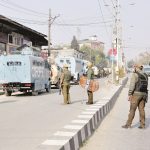JAMMU, Oct 31: Around seventeen hundred years (1700) old, the historic Bhimgarh Fort in Reasi District of Jammu region is one of the major tourist attractions of J&K as tourists from various parts of the country throng this place to have a glimpse of this historic fort.
The Bhimgarrh Fort was built by Raja Bhim Dev in the 8th century in an ordinary way after which it was named after Bhim. Later on, its walls were built with stones by Rishipal Rana and his successors.
This fort was also used by the ancestors of Risyal Rajputs. In 1672 when Gajay Singh became Raja of Jammu, he transferred Akhnoor and Reasi as Jagir to his younger brother, Jaswant Dev, who by force took over the possession of Bhim Fort after throwing out local ruling Raja.
This Fort is situated in Reasi town about 70 kms away from Jammu City. The fort has a temple, a pond, rooms of different sizes, armory and treasury. After the death of Maharaja Gulab Singh, his heirs Maharaja Ranbir Singh and Maharaja Pratap Singh used Bhimgarh Fort as a treasury and armoury.
During Maharaja Hari Singh’s rule, an English minister ordered that the armoury be destroyed and shifted the treasury to Jammu.
The Bhimgarh Fort was handed over to the Jammu and Kashmir State Archaeology Department in 1989 over the directions of the state government. In 1990, the fort was renovated by the Vaishno Devi Sthapna Board.
Jaswant Dev had two sons-Chandan Dev and Rattan Dev. He handed over Reasi to Rattan Dev and Akhnoor to Chandan Dev.
The son of Rattan Dev named Maan Singh started work of renovating walls of Fort which was also followed by one of the warriors Bhadur Singh.
Later on, Mian Diwan Singh who was involved in the murder of Mian Mota Singh (Minister of Raja Jeet Singh) became Jagirdar of Reasi but Maharaja Ranjit Singh snatched the Jagir and confined him in the prison at Lahore.
The control of the fort was then given to Maharaja Gulab Singh. In 1815, Maharaja Gulab Singh directed Diwan Amir Chand to re-construct Bhimgarh Fort. In 1817, Diwan Amir Chand brought masons from Himachal and Punjab and with the assistance of local labourers the construction work of the fort began.
When the construction work was going on, Bhup Singh succeeded in bringing back his father Diwan Singh from Lahore confinement and both reached Reasi.
With the aid of farmers of Salal Kote, they attacked the fort but at this time Zorawar Singh and his soldiers were staying inside the fort who with great valour did not allow Diwan Singh to enter the fort.
Just days after the attack on the fort, Diwan Amir Chand from Jammu immediately rushed to Reasi along with some soldiers.
He also took help from Badna Chib of Dhansal, Mian of Chanas and hundreds of other local people. They all reached Reasi to carry out an attack on Diwan Singh but before their arrival he along with his supporters had already fled towards hilly belts of Reasi.
After the attack, Maharaja Gulab Singh himself visited Reasi where he ordered his Diwan to make the fort more secure and safe.
On his directions one new entrance door and a fifty meter long and one-meter-wide stone wall was raised. After the construction of the long and thick concrete wall, no one dared to attack the fort.
The fort was also used as a treasury and armoury by Maharaja Ranbir Singh and Maharaja Pratab Singh after the death of Maharaja Gulab Singh but during the rule of Maharaja Hari Singh, the armoury was destroyed and treasury was shifted to Jammu.
According to the ADC of Maharaja Hari Singh named Nawab Khusru Jang, Bhimgarh Fort is built on the pattern of twenty-four forts of Chitorgarh.
According to historians, the Bhimgarh Fort is an amalgam of Rajsthani and Mugal architecture. There is one concrete foot path with steps from the main road to the site of the fort. On both sides of the path, elegant plantation and garden spaces are available.
On the entrance door of the Fort, a piece of Rajsthani writings can also be noticed. This door is adjoined by a 50 meters long and one-meter-wide wall having spaces to keep watchful eye on the enemies or attackers.
In the southern part of the fort, the location of twelve doors (Baradari) accessing through upstairs, gives a very different view. The roof of Baradari is concrete. From these doors one can also catch the beauty of the northern and southern area and stunning view of River Chenab.
Beneath the Baridari, the temple of Bhim Devta has been constructed. Inside the sacred temple, idols of Bhim Devta and Arjun are placed.
The body of Bhim Devta appears in clothes with iron Trisul and necklace. His mouth appears opened with flat eyes and a horn like crown on the head.
The statue of Arjun has also been shown wearing Chola (long shirt) with a long mouth. Over the temple, images of lotus flowers remind us of Harihar temple of Balpur. The idol of Ganesha can also be seen near one of the entrance doors of the fort.








